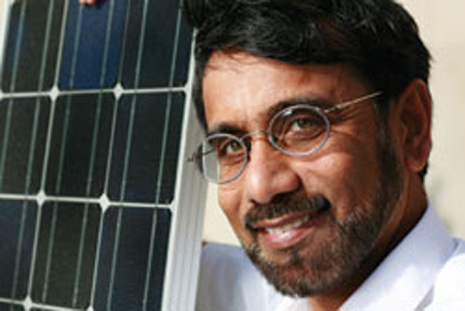Research Yields New Way to Create Poly-Silicon as Competitor for Fossil Fuel Energy
FAYETTEVILLE, Ark. – Harnessing more than 30 years of photovoltaic research experience, a University of Arkansas engineering professor has found a way to increase sunlight-to-electricity conversion efficiency and reduce the cost of expensive materials needed for solar-cell production. This technological breakthrough will decrease cost-per-watt production of solar electricity to a point at which it can compete with traditional, fossil-fuel-based methods.
“The problem with solar energy has been its cost per kilowatt hour,” said Hameed Naseem, professor of electrical engineering and director of the university’s Solid State Lab. “This applies to both production and consumption. With minimal further refinements, our technology will address this problem. The goal is to reduce the costs of silicon-based photovoltaics below those of traditional fossil-fuel-based methods such as coal, petroleum and natural gas.”
Most solar-cell technology is silicon based. There are three primary types of silicon solar cells, each named after the crystalline structure of the silicon used during fabrication:
- Mono-crystalline silicon has a single and continuous crystal lattice structure with practically zero defects or impurities.
- Poly-crystalline silicon, also called poly-silicon, comprises discrete grains, or crystals, of mono-crystalline silicon that create regions of highly uniform crystal structures separated by grain boundaries.
- Amorphous silicon is an entirely non-crystalline form of silicon that can be thought of as grains the size of the individual atoms.
Many commercialized solar cells incorporate amorphous silicon and poly-silicon, which have acceptable conversion efficiency and cost much less than mono-crystalline silicon.
The process developed by Naseem, known as topdown aluminum-induced crystallization, creates poly-silicon with crystal grains 30 times larger than grains currently produced in the photovoltaic industry. Standard poly-silicon contains grains of 0.5 to 1 micrometer, which is one-100th the diameter of a human hair. Naseem’s process yielded a grain size up to 150 micrometers, which is important because the performance of a photovoltaic device is limited primarily by defects at the boundaries of crystal grains. Increasing the size of crystal grains decreases the number of boundaries.
 The process developed by Naseem creates poly-silicon with crystal grains up to 150 micrometers, roughly 30 times larger than grains currently produced in the photovoltaic industry.
|
Traditional processing of silicon-based cells requires a heating temperature of 1,000 degrees Celsius to cause the silicon to reach a crystalline state. Naseem’s method of converting amorphous silicon into poly-silicon can be done at temperatures between 100 and 300 degrees Celsius, which saves time, materials and energy.
Naseem’s current and former students work with their teacher to test and refine the technology. Douglas Hutchings, a recent doctoral graduate of electrical engineering, partnered with Naseem and students in the Sam M. Walton College of Business to start a company, Silicon Solar Solutions LLC, which holds the licenses from the university to five patents on which the technology is based. In addition to testing and refining, the company owners plan to market the technology and identify manufacturers who are interested in integrating it into their production facilities.
Naseem and the engineers at Silicon Solar Solutions have already produced prototype solar cells that meet or exceed some performance metrics of cells made by major manufacturers. These laboratory results are competitive with commercially available solar cells and indicate the potential of Silicon Solar Solutions’ less expensive process, Hutchings said.
“Although cost-per-kilowatt hour has been the primary impediment to growth and development of solar power, this reality can be influenced by factors other than technological innovations that reduce costs,” Naseem said. “Consumer demand is one factor. As more people become aware of the problems associated with greenhouse-gas emissions, the demand for sources of clean energy goes up. This awareness and demand pressure government to invest in alternative sources of energy. This is where we are now. Now is a good time to develop solar. I predict it will take off and become a prolific and essential contributor to the nation’s power grid.”
Topics
Contacts
Hameed Naseem, professor, electrical engineering
College of Engineering
479-575-6052,
hanaseem@uark.edu
Douglas Hutchings, chief executive officer
Silicon Solar Solutions, LLC
479-363-1110,
doug@siliconsolarsolutions.com
Matt McGowan, science and research communications officer
University Relations
479-575-4246,
dmcgowa@uark.edu
Headlines
Four Students Named Goldwater Scholars; Two Earn Udall Honorable Mentions
Four U of A students have received the prestigious Goldwater Scholarship, an award for top students in mathematics, science, and engineering.
Cross-Campus Collaboration Culminates in New Outdoor Geological Installation
Grand opening event to celebrate the new GeoLab installation at the U of A’s Gearhart Hall courtyard is set for May 3. The installation will be open to the public year-round.
First Students to Use Online Degree to Hone Nursing Leadership, Elevate Patient Care
Hanna Baxendale and Wendi Kimbrell will begin coursework in the Doctor of Nursing Practice-Executive Master of Business Administration program offered by the Eleanor Mann School of Nursing and Walton College.
Join the Office for Sustainability on a Final Cruise to Campus
Cruise to Campus Wednesdays have fostered a gathering space for individuals interested in biking to campus. Drop by the Old Main Lawn from 7:30-10 a.m. Wednesday for coffee, something to eat and conversation.
Fay Jones School Student Ambassador Program Gives Voice to Design Students
The student ambassador program at the Fay Jones School of Architecture and Design is built to connect top design students with their school, its alumni, its future students and others inside and outside the school.





